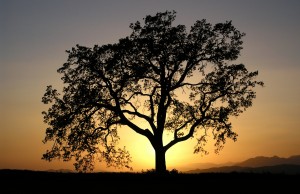April 22, 2018
Have you ever seen an aerial photo of your neighborhood or flown directly overhead? One of the most common reactions people have to seeing familiar streets from above is a surprise at how many trees there are. Especially when the canopy of the maples, oaks, and elms are at their summertime peak, your neighborhood is a fluffy green from above.
We tend to look past them as we drive to work or walk a sidewalk. We appreciate the shade on hot days and perhaps enjoy the sound of the breeze through the leaves on a cool summer evening.

Largely our trees go under-appreciated until they create a little work for us. We pay more attention when the maple “helicopter” seeds threaten to overflow our gutters, or when the ginkgo trees drop their not-so-delightful scent. Of course, our local trees get the most love during their big autumnal show of reds, oranges, and yellows. That is, until they drop their beauty all over the lawn and landscaping.
Other than that, trees, large and small, tend to blend in with our daily landscape. Even the quantity of them gets missed until seen from a different perspective.
Environmental Benefits
Occasionally you may run across data about how much environmental work trees do. However, carbon dioxide sequestration isn’t likely in the average citizen’s daily conversation. It’s a huge topic that’s hard to define, but one that dramatically impacts every living thing every single day.
To start, what was that term – carbon dioxide sequestering? This term often surfaces in global warming debates as carbon dioxide
sequestering is a way carbon can get pulled out of the atmosphere. It turns out that trees are pretty good at doing this. One half of the weight of dry wood is carbon, pulled from the atmosphere, and put into long-term storage as the makeup of the tree. Pretty cool trick, huh?
Collecting Stormwater
Another community benefit of trees lies in their ability to capture stormwater. The benefit here is two-fold. First, trees help slow runoff and erosion by temporarily storing and reducing pollutants or reducing pollutants to less harmful substances. Second, that stored rainfall doesn’t just get filtered through trees, it gets sent back into the atmosphere after being held in storage.
So we’ve got cleaner air and cleaner water from trees. But when we start talking pounds of carbon dioxide sequestered and gallons of stormwater stored, most of us have very little idea what that actually means. It sounds good, but what does a pound of carbon dioxide look like?
6 Largest Trees In Ann Arbor
To help bring some perspective to the work our leafy neighbors are doing for us without our notice, let’s focus on just a few trees. Since Twin Oaks Landscape is based in Ann Arbor, we thought we’d take a look at the six largest trees in our community and see what they’ve been up to.
6. Black Cherry (prunus serotina) on Arborview Blvd (private tree)
This tree has grown to 84 feet in height and offers a shade crown width of 55 feet. She gathers 1,074 gallons of stormwater annually and harve
sts 189 pounds of carbon dioxide.
Generally, one gallon of gasoline equals 19.4 pounds of carbon dioxide. If your vehicle averages 20 miles per gallon, you release about 1 pound of carbon dioxide per mile driven.
If we take these averages, your 189 mile trip to Columbus, Ohio to see a game this year will be covered by the Black Cherry. It will take her another year to get your return trip covered, but she’s working really hard to remove all impact from any trips you may have needed to take to Columbus, for football or otherwise.
5. Bitter Hickory (Carya cordiformis) on Linwood Ave (private tree).
The fifth largest tree in Ann Arbor stands at 83 feet tall and has an impressive 84-foot crown. This tree gathers over 700 pounds of carbon dioxide each year and stores over 6,213 gallons of water.
When we think of community water systems, we often think about treatment centers and water towers, but trees like Bitter Hickory are also doing a ton of work to protect our water resources. Water quality is increased by the volume that it filters and by the large amount that it reduces in stormwater runoff.
The average household of three uses between 6,000-7,500 gallons of water a month. If you’ve got a baby, teenager or swimming pool, the
average goes up. But as your family grows and changes, Bitter Hickory will be busy storing and filtering a whole month of your water supply.
4. Our fourth largest tree is American Sycamore (Platanus occidentalis) at 4090 Geddes Ave (street tree).
At 80 feet tall and 135 inches around, she’s as sturdy as she is beautiful. She gathers nearly 7,100 gallons of stormwater each year and 1,514 pounds of carbon dioxide.
Carbon dioxide occurs naturally in the Earth’s atmosphere as it circulates through plants, animals, soils, and oceans. Human activities, such as vehicle emissions and home heating distribute additional carbon dioxide into the air, making trees like American Sycamore more important in helping to capture the additional output.
In 2016, the average home in the United States consumed 12,148 kWh, which translates into 6.67 metric tons of carbon dioxide annually. A tree like American Sycamore accounts for approximately 10% of that emission each year, sequestering 1,514 pounds herself. Approximately ten trees like her sequester an average American household’s energy each year.
3. An American Sweetgum (Liquidambar styraciflua) stands at 1201 Bydding Rd (private tree)
With a height of 80 feet and a circumference of 72 inches. It collects 2,900 gallons of stormwater and 584 pounds of carbon dioxide each year.
2,900 gallons of water sounds like a lot, but just how much is that? For reference, American Sweetgum stores and filters the capacity of a cement mixer truck each year. Alternatively, 2,900 gallons is almost 200 beer kegs. That’s a lot of water and one heck of a party.
2. The American Linden (Tilia americana) at 719 Spring St. (street tree)
Standing at a shorter height than our other top trees at 55 feet, the American Linden has a full 162-inch circumference and a 38-foot shade crown. The 5,029 gallons of stormwater and 553 pounds of carbon dioxide it collects each year provides an annual energy savings of $112.
Energy savings from trees? Yes! One of the main ways a tree saves energy costs is by providing shade, reducing cooling costs. The canopy and location of the tree both impact these savings.
A tree planted within 60 feet of the west side of a home, or within 40 feet of the south side of a home can reduce a home’s summertime cooling costs by up to $25 a year. Though American Linden’s energy savings isn’t just limited to its shading, it is saving about 4.5 households of energy costs each year, just by standing there looking beautiful.
1. Rounding out our top six trees in Ann Arbor is the American Elm (Ulmus americana) at 508 Spring St. (street tree).
This tree is as substantial as it is efficient. It stands at 82 feet, with a 55-foot crown. It sequesters 7,390 gallons of stormwater and 1,946 pounds of carbon dioxide.
This tree’s work has produced an energy savings of $433 and $162 each year. Much of these savings have to do with American Elm’s relationship to water. Not only is it filtering an impressive number of stormwater gallons each year, but with a substantial crown, it produces shade benefits, regardless of its proximity to energy-using buildings.
Trees Are Cool!
Trees help cool our neighborhoods in two ways. One by shading the ground from direct sunlight. The other is by literally cooling the air by evaporating water through their leaves, taking some heat out of the air in the process.
So while the beauty of trees filling a neighborhood is perhaps the most recognizable benefit, a city filled with energy-reducing trees makes it altogether more temperate and less expensive.
You still may not notice every tree in your neighborhood until it drops leaves all over your car. And you’ll pass dozens of them on your way to work without considering their significance. But rest assured that all the time, these six trees and hundreds more like them are silently pumping clean, cool air into our community every day. They’re supporting our waterways and making our neighborhoods more sustainable.
Click here o see the full list of the biggest trees in Ann Arbor.
At Twin Oaks Landscape, our tree specialists can evaluate and help you maximize the environmental benefits of your trees. If you would like to add to or curate your own trees, contact Twin Oaks Landscape today.
Gallery
“We recommend Twin Oaks to any entity looking for a full-service, talented, and responsive provider.”
